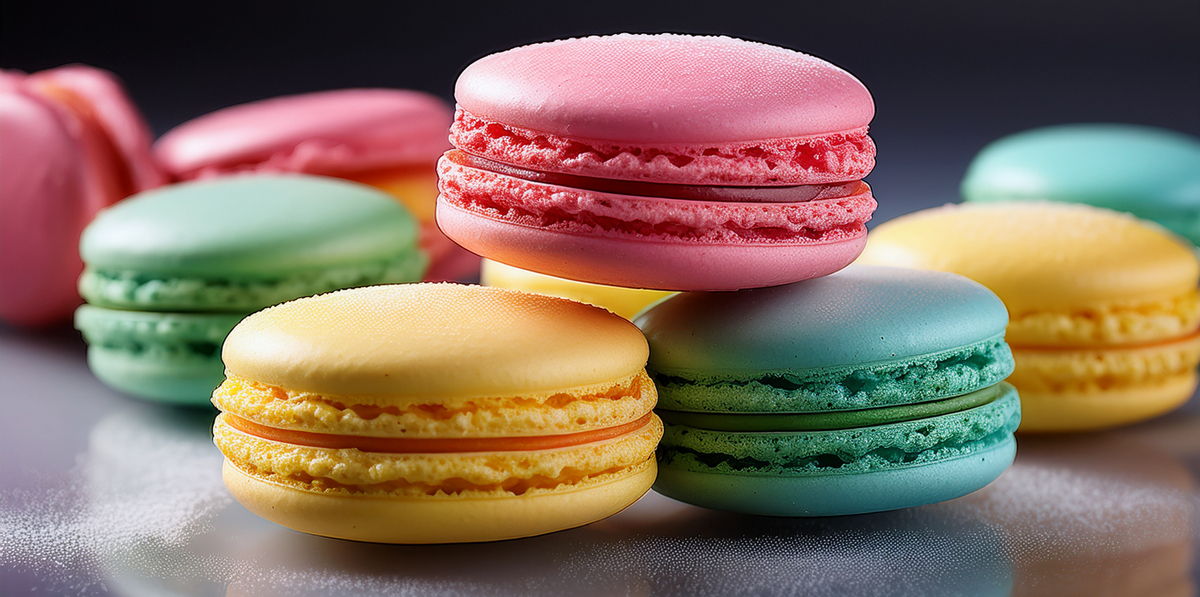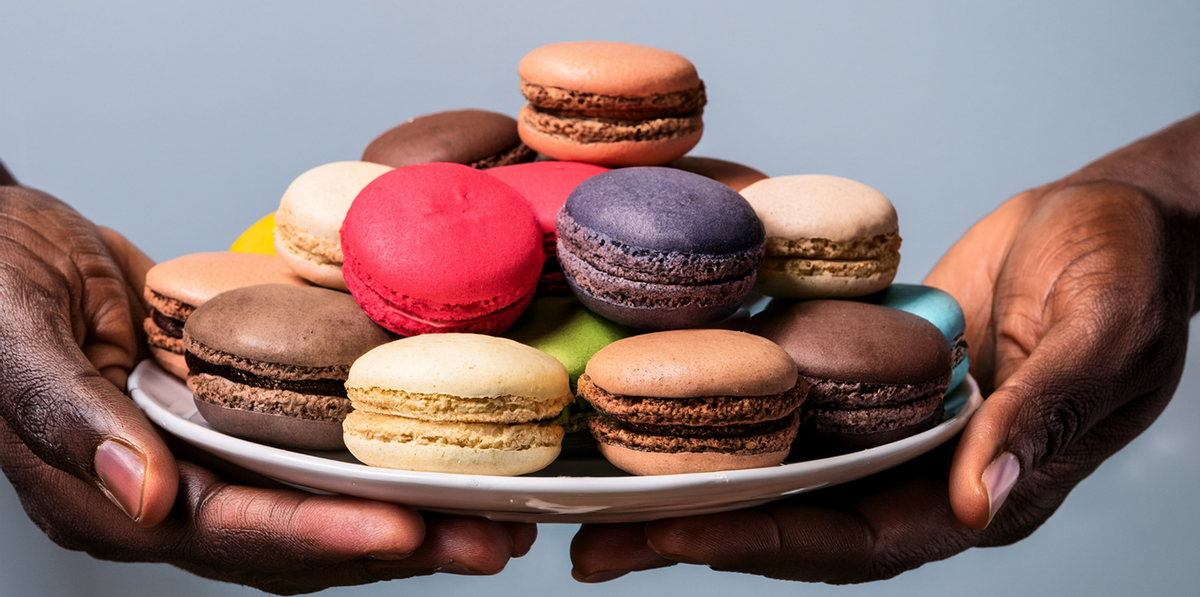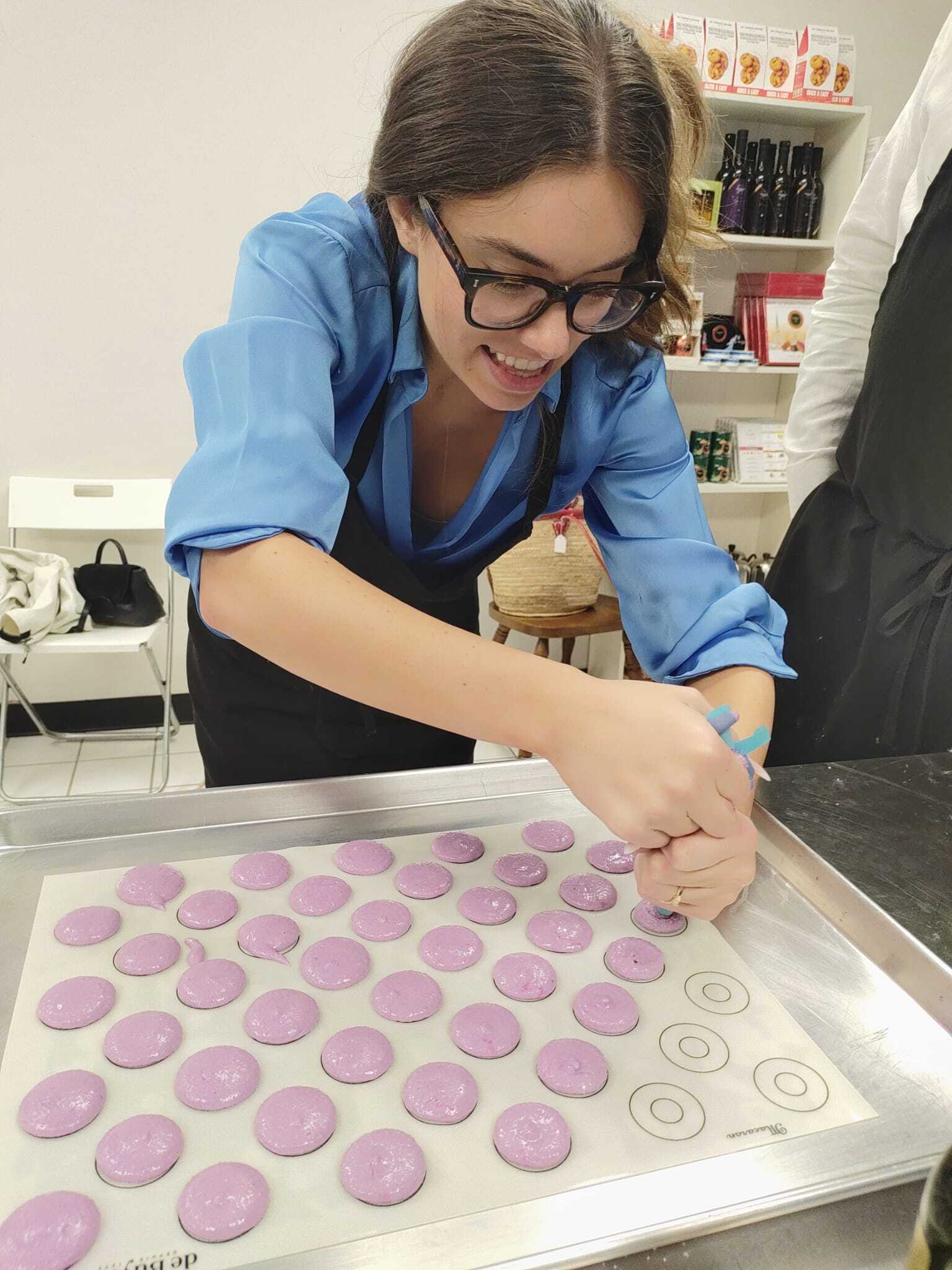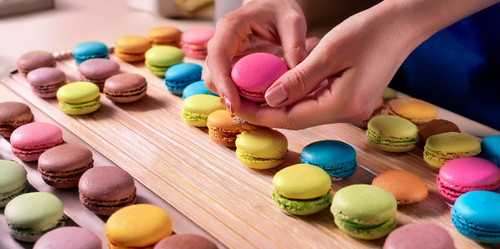Apr 10th 2025
Understanding Macaron Ingredients: A Guide for a good start
At its heart, a macaron is a simple yet sophisticated dessert composed of meringue-based cookies paired together with a luscious filling.
The key to mastering this confection lies in understanding the ingredients and the role they play in creating that perfect bite.
The Almond Flour
One of the defining ingredients in macarons is almond flour. This fine flour gives macarons their signature texture, a delicate crispness on the outside and a chewy, almost melt-in-your-mouth interior. Almond flour provides a subtle nutty flavor that perfectly complements the sweetness of the meringue, making it an essential component of the macaron ingredients list.
Choosing the Right Almond Flour
Not all almond flours are created equal. When selecting almond flour for macarons, opt for a finely ground variety. Coarser flours can lead to a gritty texture, detracting from the smoothness that macarons are known for. Blanched almond flour, which has the skins removed, is preferred for its pale color and smooth texture.
Storing Almond Flour
Proper storage of almond flour is crucial to maintaining its quality. Almond flour can go rancid if not stored correctly. Keep it in an airtight container in a cool, dry place. For long-term storage, consider refrigerating or freezing it to prolong its shelf life and preserve its delicate flavor.
Substituting Almond Flour
While almond flour is traditional, some may seek alternatives due to allergies or dietary preferences. Ground sunflower seeds or pumpkin seeds can sometimes be used as substitutes, though they may alter the taste and texture slightly. Experimentation and adjustments in other ingredients may be necessary to achieve similar results.
The Egg Whites
The backbone of the macaron shell is the meringue, which is made from egg whites. These egg whites are whipped to form stiff peaks, creating the structure that allows the macaron to rise and develop its characteristic "feet": the ruffled edges at the base of the cookies. The quality of the meringue can make or break your macarons, so it's crucial to whip the egg whites to perfection.
Aging Egg Whites
Aging egg whites is a technique often employed by seasoned macaron makers. This involves separating the egg whites a day or two in advance and allowing them to sit in the refrigerator. Aging helps reduce moisture content, which can lead to a more stable meringue and better macaron structure.
Whipping Techniques
Whipping egg whites to the perfect consistency is an art form in itself. Begin at a slow speed to build small, stable bubbles before increasing to a medium-high speed. This gradual approach helps achieve the stiff peaks necessary for a strong, airy meringue. Over-whipping can lead to a dry meringue that lacks the necessary elasticity.
Troubleshooting Meringue
Several factors can affect the quality of your meringue, from the cleanliness of your mixing bowl to the temperature of the room. Ensure your mixing bowl and utensils are free of grease, as any oil can prevent egg whites from whipping properly. Additionally, room-temperature egg whites tend to whip more efficiently than cold ones.
Sugar
Sugar is the sweetener that balances the flavors in a macaron. Granulated sugar is typically added to the egg whites to stabilize the meringue, while powdered sugar is mixed with almond flour to ensure a smooth, lump-free batter. The amount of sugar used is critical; too little can affect the texture, while too much can make the macarons overly sweet.
Types of Sugar
Understanding the types of sugar used in macarons can help in crafting the perfect dessert. Granulated sugar is best for stabilizing meringue, adding it gradually as you whip the egg whites. Powdered sugar, on the other hand, mixes with almond flour to form the base of the macaron batter, offering a smooth consistency.
Adjusting Sweetness
For those who prefer less sweetness, adjusting sugar levels requires careful consideration. Reducing sugar can affect the texture and stability of the meringue. If you need to adjust sweetness, consider doing so in the filling instead of the shell. You can use a lemon curd or a raspberry curd that will brung just the right amount of tangyness.
Sugar Alternatives
For those seeking alternatives to traditional sugar, options such as coconut sugar or erythritol are available. Each alternative comes with its own set of challenges, including differences in sweetness levels and moisture content, which can impact the final product. Experimentation is key to finding the right balance.
Food Coloring
While not a traditional ingredient, food coloring is often added to macaron batter to create vibrant, visually appealing cookies. Whether you prefer the classic pastel hues or bold, striking colors, a few drops of gel or powdered food coloring can transform your macarons into a feast for the eyes.
Choosing the Right Type of Coloring
When it comes to coloring macarons, gel and powdered food colorings are recommended over liquid. Liquid colorings can alter the consistency of the batter, while gels and powders provide vibrant hues without affecting texture. Choose high-quality products for the best results.
Mixing Colors
Creating unique shades is part of the fun of macaron making. Mix primary colors to achieve desired hues, keeping in mind that baking can sometimes alter the vibrancy. Start with a small amount of coloring and add gradually to avoid over-saturation.

Avoiding Common Mistakes
Over-mixing food coloring can impact the macaron batter's consistency. To prevent this, incorporate coloring during the early stages of meringue preparation. This allows for even distribution without the risk of overworking the batter.
Flavorings
Flavorings are where the creativity of macaron-making truly shines. From vanilla and chocolate to more adventurous options like lavender or matcha, the possibilities are endless. These flavorings can be added to the meringue or incorporated into the filling, allowing you to craft a unique taste profile for each batch of macarons.
Traditional Flavors
Classic macaron flavors such as vanilla, chocolate, and raspberry remain popular for their timeless appeal. Vanilla powder or cocoa powder can be added to the batter or filling, providing a familiar yet delightful taste experience.
Innovative Flavors
For the adventurous, experimenting with unique flavors can lead to exciting results. Ingredients like matcha, lavender, or even savory elements like herbs and spices can create macarons with a modern twist. Pair these flavors with complementary fillings to enhance the overall taste.
Balancing Flavors
Achieving the perfect balance of flavors requires a keen palate. The sweetness of the shell should harmonize with the filling, creating a cohesive taste experience. When incorporating strong flavors, use them sparingly to avoid overwhelming the delicate nature of the macaron.
The Art of the Filling
The filling is what brings the macaron together, providing a burst of flavor that complements the shell. Common fillings include buttercream, ganache, and fruit preserves, each offering a different texture and taste experience.
Buttercream
Buttercream is a popular choice for macaron fillings due to its creamy texture and versatility. It can be flavored with various extracts, fruits, or spices, allowing for endless customization. The key to a smooth buttercream is to ensure it's whipped to a light and airy consistency.
Types of Buttercream
There are several types of buttercream to consider, including Swiss, Italian, and American styles. Each has its unique preparation method and texture. Swiss and Italian buttercreams are known for their smoothness and stability, while American buttercream is simpler to prepare and offers a sweeter taste.
Flavoring Buttercream
The versatility of buttercream allows for a wide range of flavorings. From classic vanilla and chocolate to exotic fruits and spices, the possibilities are vast. Infuse buttercream with purees or extracts for a burst of flavor that complements the macaron shell.
Troubleshooting Buttercream
Achieving the perfect buttercream consistency can be challenging. If the mixture curdles or becomes too stiff, gradually add a little cream or milk while whipping. For overly soft buttercream, chilling it slightly can help achieve the desired texture.
Ganache
For those who prefer a richer filling, ganache is an excellent option. Made from chocolate and cream, ganache provides a decadent, silky center that pairs beautifully with the delicate macaron shell. When making ganache, it's important to use high-quality chocolate to achieve the best flavor and texture.
Types of Chocolate
The choice of chocolate can significantly impact the ganache. Dark, milk, and white chocolates each offer distinct flavors and textures. Dark chocolate offers a rich, intense flavor, while milk and white chocolates are creamier and sweeter, allowing for diverse taste profiles.
Preparing Ganache
Making ganache involves carefully melting chocolate with heated cream. The key is to achieve a smooth, glossy mixture. Allow the ganache to cool slightly before using it as a filling, ensuring it reaches the right consistency for piping between the macaron shells.
Flavored Ganache
Enhancing ganache with flavors like liqueurs, spices, or fruit zest can elevate the macaron experience. Infuse the cream with these elements before combining with chocolate for a seamless blend of flavors that complement the macaron shell. Try this chocolate lavender ganache. We love how the lavender brings a light florar taste complimenting the chocolate without overpowering it.
Fruit Preserves
Fruit preserves offer a fresh, tangy contrast to the sweetness of the macaron. They can be used alone or combined with other fillings to create a complex flavor profile. When using fruit preserves, opt for those with a smooth consistency to ensure an even spread between the macaron shells.
Choosing the Right Preserves
Select high-quality fruit preserves with a smooth texture for the best results. Avoid chunky or overly watery preserves, as they can cause the macaron shells to become soggy. Strain preserves if necessary to achieve a consistent texture.
Combining with Other Fillings
Fruit preserves can be paired with buttercream or ganache to create layered flavors. For instance, a raspberry preserve with chocolate ganache offers a delightful mix of sweet and tart, while citrus preserves can brighten a vanilla buttercream.

The Science Behind the Perfect Macaron
Creating macarons requires a delicate balance of technique and timing. Here are some key tips to help you achieve success:
Sifting
Sifting the almond flour and powdered sugar is essential to prevent lumps and ensure a smooth batter. This step might seem tedious, but it makes a significant difference in the final texture of your macarons.
Importance of Sifting
Sifting removes clumps from almond flour and powdered sugar, ensuring a smooth, lump-free batter. This process helps create a uniform texture in the macaron shell, contributing to their delicate appearance and mouthfeel.
Proper Sifting Techniques
Use a fine-mesh sieve or sifter to thoroughly combine the dry ingredients. Sift multiple times if necessary, especially if the almond flour is coarse. This extra step can prevent unwanted lumps from forming during mixing.
Troubleshooting Sifting
If sifting reveals large chunks of almond flour, consider regrinding or discarding them. Ensuring all dry ingredients are properly sifted will prevent uneven textures and help maintain the integrity of the macaron shell.
Folding
The process of folding the dry ingredients into the meringue is known as "macaronage." This technique requires a gentle hand to maintain the airiness of the meringue while fully incorporating the ingredients. The batter should flow like lava, neither too runny nor too stiff.
Mastering Macaronage
Macaronage is a critical step where precision is key. Use a spatula to fold the dry ingredients into the meringue, turning the bowl as you go. The goal is to achieve a smooth, shiny batter that flows like lava when lifted.
Recognizing Proper Consistency
The right consistency allows the batter to settle into smooth rounds when piped. If the batter is too thick, it will hold peaks and not spread properly. Conversely, a runny batter will spread too much, resulting in flat macarons without feet.
Common Mistakes in Folding
Over-mixing can deflate the meringue, while under-mixing can lead to uneven batter. Practice and patience are essential in mastering this technique. Observing the batter's flow and adjusting your folding technique accordingly will improve your results.

Resting
Allowing the piped macarons to rest before baking is crucial for developing the iconic "feet." This rest period helps the batter form a skin, which allows the macarons to rise evenly in the oven.
Why Resting is Important
Resting allows the surface of the macarons to dry, forming a thin skin. This skin is essential for creating the distinctive feet during baking and preventing the tops from cracking.
Ideal Resting Conditions
The resting time can vary depending on humidity and temperature. On average, 20-30 minutes is sufficient, but it may take longer in humid conditions. The surface should feel dry to the touch before baking.
Adjusting Resting Time
If macarons don't develop feet, consider extending the resting period. Conversely, if they crack, they may have rested too long. Finding the right balance requires observation and adjustment based on your environment.
Baking
The baking process is where precision matters most. Oven temperature and timing can vary, so it's important to monitor your macarons closely to prevent overbaking. A perfectly baked macaron will have a firm shell with a slightly chewy center.
Setting the Right Temperature
An accurate oven temperature is crucial for even baking. Use an oven thermometer to ensure your oven is calibrated correctly. Too high a temperature can cause macarons to brown, while too low can prevent proper rising.
Timing Your Bake
The average baking time for macarons is around 12-15 minutes. Begin checking them at 10 minutes to ensure they don't overbake. The shells should be firm to the touch but not browned.
Cooling and Storing Macarons
Once baked, allow macarons to cool completely before removing them from the baking sheet. Store them in an airtight container in the refrigerator to mature flavors and achieve the perfect texture before serving.
Crafting Memories with Macarons
Macarons are more than just a dessert; they are a canvas for creativity and a vessel for memories. Whether you're crafting them for a special occasion or simply to share with loved ones, these little confections have the power to create moments of joy and connection.
Sharing the Experience
Macarons are often shared during celebrations and gatherings, making them ideal for creating cherished memories. Their colorful appearance and delightful flavors make them a favorite among both young and old, fostering moments of joy and connection.
Hosting a Macaron making Party
Consider hosting a macaron-making party with friends or family. This interactive experience allows participants to learn and create together, sharing tips and techniques. It’s a delightful way to bond over the art of baking and enjoy the fruits of your labor.
Join a Macaron cooking class
Macarons cooking classes are the perfect way to learn the basics of this oconic French pastry. Learning first from someone with experience will prevent you from making mistakes.
Gifting Macarons
Macarons make for thoughtful gifts, perfect for any occasion. Present them in decorative boxes or jars, personalized with handwritten notes. This gesture not only showcases your culinary skills but also conveys your care and effort.
Embracing the Learning Process
As you master the art of macarons, remember that each batch is a learning experience. Embrace the process, savor the flavors, and enjoy the journey of bringing a touch of French elegance into your kitchen. With practice and patience, you'll soon be crafting macarons that not only delight the palate but also tell a story.
Learning from Mistakes
Not every batch will be perfect, and that's part of the journey. Analyze any issues and make adjustments for future attempts. Each mistake is an opportunity to refine your technique and improve your results.
Documenting Your Progress
Keep a macaron journal to document your successes and challenges. Note the ingredients used, techniques applied, and outcomes achieved. This record will serve as a valuable reference for future baking endeavors.
Celebrating Achievements
Celebrate the small victories along the way, whether it's achieving perfect feet or nailing a new flavor combination. Each success is a milestone in your journey toward mastering the art of macaron making.
Inspiring Creativity
In conclusion, understanding the ingredients and techniques behind macarons is the first step in creating a dessert that transcends taste. With a dash of creativity and a sprinkle of passion, you'll be well on your way to becoming a macaron maestro, crafting confections that leave a lasting impression.
Exploring New Ideas
Let your imagination run wild as you experiment with new flavors, colors, and designs. The possibilities are endless, and each new creation is an opportunity to express your unique culinary style.
Sharing Your Creations
Share your macaron creations on social media or with local food groups. Engaging with fellow enthusiasts can provide inspiration, feedback, and a sense of community. It’s a wonderful way to connect with others who share your passion.

